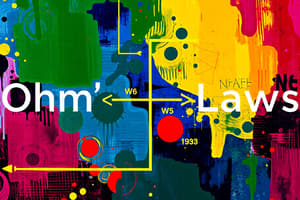Podcast
Questions and Answers
What is the purpose of connecting individual electrical elements into a network?
What is the purpose of connecting individual electrical elements into a network?
To analyze the performance of electrical devices such as motors, generators, transformers, electrical transducers, and electronic devices.
What are the two types of sources commonly found in an electrical circuit?
What are the two types of sources commonly found in an electrical circuit?
Voltage sources and current sources.
Ohm's Law states that the current flowing in a circuit is inversely proportional to the applied voltage, assuming constant temperature.
Ohm's Law states that the current flowing in a circuit is inversely proportional to the applied voltage, assuming constant temperature.
False (B)
Kirchhoff's Voltage Law states that the algebraic sum of the voltages in any ______ path in a network is zero.
Kirchhoff's Voltage Law states that the algebraic sum of the voltages in any ______ path in a network is zero.
What is the term used to describe the voltage created by current flowing through a passive element?
What is the term used to describe the voltage created by current flowing through a passive element?
Which of the following is NOT a common electrical device analyzed by studying circuits?
Which of the following is NOT a common electrical device analyzed by studying circuits?
What is the constant of proportionality in Ohm's Law?
What is the constant of proportionality in Ohm's Law?
What is the relationship between current (I), voltage (V), and resistance (R) as expressed by Ohm's Law?
What is the relationship between current (I), voltage (V), and resistance (R) as expressed by Ohm's Law?
The ______ current method is a technique used to analyze circuits.
The ______ current method is a technique used to analyze circuits.
What is the purpose of connecting individual circuit elements in a network?
What is the purpose of connecting individual circuit elements in a network?
What is Ohm's law?
What is Ohm's law?
What is the formula for Ohm's law?
What is the formula for Ohm's law?
What is Kirchhoff's Voltage Law (KVL) and what does it state?
What is Kirchhoff's Voltage Law (KVL) and what does it state?
Kirchhoff's Voltage Law only applies to circuits driven by constant sources (DC).
Kirchhoff's Voltage Law only applies to circuits driven by constant sources (DC).
What are the two types of voltages that contribute to the sum in Kirchhoff's Voltage Law?
What are the two types of voltages that contribute to the sum in Kirchhoff's Voltage Law?
Flashcards
Electric circuit
Electric circuit
An interconnected set of individual circuit elements, typically including at least one voltage or current source.
Circuit constraints
Circuit constraints
The constraints imposed on the currents and voltages in a circuit due to the arrangement of its elements.
Circuit equations
Circuit equations
The mathematical expressions that describe the relationships between currents and voltages in a circuit.
Ohm's Law
Ohm's Law
Signup and view all the flashcards
Resistance
Resistance
Signup and view all the flashcards
Kirchhoff's Voltage Law (KVL)
Kirchhoff's Voltage Law (KVL)
Signup and view all the flashcards
Source Voltages
Source Voltages
Signup and view all the flashcards
Voltage drops
Voltage drops
Signup and view all the flashcards
DC source
DC source
Signup and view all the flashcards
Time-variable Source
Time-variable Source
Signup and view all the flashcards
Mesh current method
Mesh current method
Signup and view all the flashcards
Motors
Motors
Signup and view all the flashcards
Generators
Generators
Signup and view all the flashcards
Transformers
Transformers
Signup and view all the flashcards
Electrical Transducers
Electrical Transducers
Signup and view all the flashcards
Electronic Devices
Electronic Devices
Signup and view all the flashcards
Circuit Analysis
Circuit Analysis
Signup and view all the flashcards
Operating Conditions
Operating Conditions
Signup and view all the flashcards
Performance Analysis
Performance Analysis
Signup and view all the flashcards
Source of Energy
Source of Energy
Signup and view all the flashcards
Study Notes
Electric Circuits
- Electric circuits are interconnected single circuit elements
- At least one voltage or current source is present
- Arrangement of elements creates new constraints between currents and voltages
- Constraints and element relationships provide the solution
- Analysis is used to understand motors, generators, transformers, transducers, and electronics
- Solutions provide operational information under applied conditions
- Purpose of defining and connecting elements is to analyze electrical devices
Ohm's Law
- Current (I) is directly proportional to voltage (V) if temperature is constant
- V ∝ I
- V = IR (where R is resistance)
- Resistance (R) is the constant of proportionality
Kirchhoff's Voltage Law (KVL)
- For any closed path in a network, the algebraic sum of voltages is zero
- Voltages can be from sources or from current in passive elements (voltage drops)
- Applies equally to constant (DC), time-variable and other sources
Studying That Suits You
Use AI to generate personalized quizzes and flashcards to suit your learning preferences.




